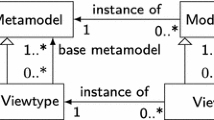Abstract
A Unified Modeling Language model of a software system can be represented by a sequence of model transformations, starting from an empty model. To effectively support the design of complex systems, transformations help the developer to proceed from an initial requirements model to a platform-specific, executable model. We present a notion of potentially re-orderable model transformations that assist the developer in the design process, and track the semantic dependencies of the different modeling steps. Based on our experience with our own software engineering methodology and modeling tool, we outline a possible implementation that will support developers in revising their model, and still benefit from any subsequent effort that has been spent on model evolution, especially with regard to correctness of the evolving model.
Similar content being viewed by others
Explore related subjects
Discover the latest articles and news from researchers in related subjects, suggested using machine learning.References
ATLAS Group. ATLAS Transformation Language. http://www.eclipse.org/m2m/atl/
Chen Z, Liu Z, Ravn AP, Stolz V, Zhan N (2009) Refinement and verification in component-based model driven design. Sci Comput Program 74(4):168–196. Special Issue on the Grand Challenge. UNU-IIST TR 388
Chen Z, Morisset C, Stolz V (2009) Specification and validation of behavioural protocols in the rCOS modeler. In: Sirjani M, Arbab F (eds) 3rd international symposium on fundamentals of software engineering (FSEN 2009). http://rcos.iist.unu.edu/publications/fsen09.pdf (to be published)
Gamma E, Helm R, Johnson R, Vlissides J (1995) Design patterns: elements of reusable object-oriented software. Addison-Wesley, Reading
Giese H, Wagner R (2009) From model transformation to incremental bidirectional model synchronization. Softw Syst Model 8(1): 3
He J, Liu Z, Li X (2006) rCOS: A refinement calculus of object systems. Theor Comput Sci 365(1–2): 109–142 UNU-IIST TR 322
Liu Z, Mencl V, Ravn AP, Yang L (2006) Harnessing theories for tool support. In: Proceedings of the second international symposium on leveraging applications of formal methods, verification and validation (isola 2006), pp 371–382. IEEE Computer Society. Full version as UNU-IIST TR 343
Liu Z, Morisset C, Stolz V (2009) rCOS: theory and tools for component-based model driven development. In: Sirjani M, Arbab F (eds) 3rd international symposium on fundamentals of software engineering (FSEN 2009). Keynote UNU-IIST TR 406 (to be published)
Nielson F, Nielson HR, Hankin C (2004) Principles of program analysis. Springer, Berlin
Object Management Group. Model Driven Architecture (MDA) FAQ. http://www.omg.org/mda/faq_mda.htm#delivering%20mda. Last accessed October 1, 2009
Object Management Group (2005) MOF QVT final adopted specification, ptc/05-11-01. http://www.omg.org/docs/ptc/05-11-01.pdf
Pontisso N, Chemouil D (2006) TOPCASED Combining formal methods with model-driven engineering. In: ASE ’06: proceedings of the 21st IEEE/ACM international conference on automated software engineering, Washington, DC, USA. IEEE Computer Society, pp 359–360
Spinellis D (2003) On the declarative specification of models. IEEE Softw 20(2): 94–96
Steinberg D, Budinsky F, Paternostro M, Merks E (2008) EMF: eclipse modeling framework, 2nd edn. Addison-Wesley Professional, Reading
Störrle H (2007) A PROLOG-based approach to representing and querying software engineering models. In: Cox PT, Fish A, Howse J (eds) VLL 2007 workshop on visual languages and logic. CEUR workshop proceedings, vol 274, pp 71–83. CEUR-WS.org
Triskell research team. Kermeta. http://www.kermeta.org
Warmer J, Kleppe A (1999) The object constraint language: precise modeling with UML. Addison-Wesley, Reading
Author information
Authors and Affiliations
Corresponding author
Rights and permissions
About this article
Cite this article
Stolz, V. An integrated multi-view model evolution framework. Innovations Syst Softw Eng 6, 13–20 (2010). https://doi.org/10.1007/s11334-009-0102-7
Received:
Accepted:
Published:
Issue Date:
DOI: https://doi.org/10.1007/s11334-009-0102-7




